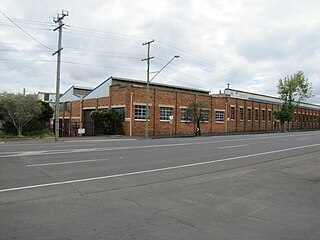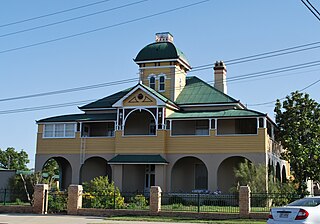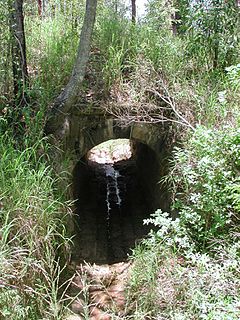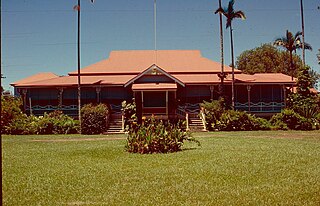
Grandchester is a rural town and locality in the City of Ipswich, Queensland, Australia. In the 2016 census, Grandchester had a population of 444 people.

The Queensland Railways A10 Neilson class locomotive was a class of 0-4-2 steam locomotives operated by the Queensland Railways.

Mitchell railway station is located on the Western line in the Maranoa Region, Queensland, Australia. It serves the town of Mitchell. The station has one platform, opening in 1885. The station has a number of heritage-listed buildings, including the passenger station in Oxford Street, the goods shed in Alice Street, and the station master's house in Sheffield Street. The buildings were added to Queensland Heritage Register on 8 September 2005.

Toowoomba Foundry Pty Ltd is a heritage-listed former foundry at 251-267 Ruthven Street, Toowoomba, Queensland, Australia. It was built from c. 1910 to 1940s. It is also known as Griffiths Brothers & Company, Southern Cross Works, and Toowoomba Foundry and Railway Rolling Stock Manufacturing Company. It was added to the Queensland Heritage Register on 7 July 2004. The northern and western portions of the site have undergone redevelopment as a Bunnings Warehouse outlet, having obtained Toowoomba Regional Council approval to demolish some of the heritage-listed structures on the site. Construction commenced in late 2016, with the store opening in late 2017.

Murphys Creek Railway Complex is a heritage-listed railway yard on the Main Line railway at Odin Street, Murphys Creek, Queensland, Australia. It was built from 1921 to c. 1949. It is also known as Murphys Creek Locomotive Water Tank & Tower. It was added to the Queensland Heritage Register on 24 September 1999.

Main Range Railway is a heritage-listed railway from the end of Murphys Creek railway station, Murphys Creek to the Ruthven Street overbridge, Harlaxton, Queensland, Australia. It forms part of the Main Line railway and was built from 1865 to 1867 by railway builders Peto, Brassey and Betts. It was added to the Queensland Heritage Register on 5 February 2009.

Sadliers Crossing Railway Bridge is a heritage-listed railway bridge at over Bremer River between Tallon Street, Sadliers Crossing and Dixon Street, Wulkuraka, Queensland, Australia on the Main Line (this section is now the Ipswich and Rosewood railway line. It was added to the Queensland Heritage Register on 13 November 2008.

Grand View Hotel is a heritage-listed hotel at 49 North Street, Cleveland, City of Redland, Queensland, Australia. It was built c. 1852 onwards. It was also known as Brighton Hotel and Cleveland House. It was added to the Queensland Heritage Register on 21 October 1992.

Wallangarra railway station is a heritage-listed railway station at Woodlawn Street, Wallangarra, Southern Downs Region, Queensland, Australia. It was built in 1877 along the state border of Queensland and New South Wales It was added to the Queensland Heritage Register on 28 March 2003.

Franklyn Vale Homestead is a heritage-listed homestead at Franklin Vale Road, Mount Mort, City of Ipswich, Queensland, Australia. It was built in the early 1870s. It was added to the Queensland Heritage Register on 21 October 1992.

Grandchester Sawmills is a heritage-listed sawmill business at Symes Street, Grandchester, City of Ipswich, Queensland, Australia. It was built in 1941. It was added to the Queensland Heritage Register on 21 October 1992.

The Sandstone Railway Culvert is a heritage-listed railway culvert at Wulkuraka, City of Ipswich, Queensland, Australia. It was built c. 1865. It was added to the Queensland Heritage Register on 24 June 2005.

Warwick railway station is a heritage-listed railway station on the Southern railway line in Warwick, Southern Downs Region, Queensland, Australia. It was built from c. 1881 to 1910s. It was added to the Queensland Heritage Register on 24 September 1999.

St Mary's Presbytery is a heritage-listed Roman Catholic presbytery of St Mary's Roman Catholic Church at 142 Palmerin Street, Warwick, Southern Downs Region, Queensland, Australia. It was designed by Wallace & Gibson and built from 1885 to 1887 by John McCulloch. It is also known as Father JJ Horan's private residence. It was added to the Queensland Heritage Register on 31 July 2008.

Emerald railway station is a heritage-listed railway station on the Central Western railway line at Clermont Street, Emerald, Central Highlands Region, Queensland, Australia. The building design was signed by Henrik Hansen was built in 1900 by Thomas Moir. It was added to the Queensland Heritage Register on 21 October 1992.

Sandstone Railway Culvert is a heritage-listed culvert at about 130 metres (430 ft) west of the corner of WM Hughes Street and Musgrave Street, North Ipswich, City of Ipswich, Queensland, Australia. It was built between 1864 and 1865. It was added to the Queensland Heritage Register on 13 November 2008.

Greenmount Homestead is a heritage-listed homestead at Greenmount Road, Walkerston, Mackay Region, Queensland, Australia. It was designed by William Sykes and built in 1915 by Arthur Carter & Co. It was added to the Queensland Heritage Register on 6 September 1993.

The Normanton to Croydon railway line is a heritage-listed railway line in the Gulf Country of northern Queensland, Australia. The railway line linking Normanton in the Shire of Carpentaria to Croydon in the Shire of Croydon was built between 1888 and 1891 and is the last isolated line of Queensland Rail still in use. It utilises an innovative system of submersible track with patented steel sleepers and retains buildings of considerable architectural and technical interest at its terminus in Normanton. The only train to operate on the line is the weekly Gulflander service operated by a Gardner diesel propelled railmotor and carriages TP1809 and TP1811.

Normanton railway station is a heritage-listed railway station at Matilda Street, Normanton, Shire of Carpentaria, Queensland, Australia. It was built in 1889. It was added to the Queensland Heritage Register on 21 October 1992. It serves as a tourist attraction and station for the Gulflander line.

The 1873 Roma Street railway station building is a heritage-listed railway station building at Roma Street railway station, 159 Roma Street, Brisbane central business district, City of Brisbane, Queensland, Australia. It was designed by Francis Drummond Greville Stanley and built from 1873 to 1875 by John Petrie. It is also known as Brisbane Passenger Station, Brisbane Terminal Station, and Brisbane Terminus. It was added to the Queensland Heritage Register on 24 March 2000.
























